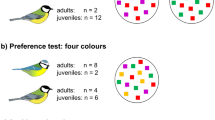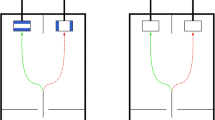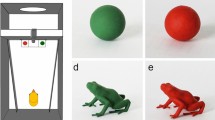Abstract
Using featural cues such as colour to identify ephemeral food can increase foraging efficiency. Featural cues may change over time however; therefore, animals should use spatial cues to relocate food that occurs in a temporally stable position. We tested this hypothesis by measuring the cue preferences of captive greenfinches Carduelis chloris when relocating food hidden in a foraging tray. In these standardised associative learning trials, greenfinches favoured colour cues when returning to a foraging context that they had encountered before only once (“one-trial test”) but switched to spatial cues when they had encountered that scenario on ten previous occasions (“repeated-trial test”). We suggest that repeated encounters generated a context in which individuals had a prior expectation of temporal stability, and hence context-dependent cue selection. Next, we trained birds to find food in the absence of colour cues but tested them in the presence of visual distracters. Birds were able to learn spatial cues after one encounter, but only when visual distracters were identical in colouration. When a colourful distracter was present in the test phase, cue selection was random. Unlike the first one-trial test, birds were not biased towards this colourful visual distracter. Together, these results suggest that greenfinches are able to learn both cue types, colour cue biases represent learning, not simply distraction, and spatial cues are favoured over colour cues only in temporally stable contexts.




Similar content being viewed by others
References
Baddeley RJ, Osorio D, Jones CD (2007) Generalization of color by chickens: experimental observations and a bayesian model. Am Nat 169:S27–S41
Bennett ATD (1993) Spatial memory in a food storing corvid I: near tall landmarks are primarily used. J Comp Physiol A 173:193–207
Brodbeck DR (1994) Memory for spatial and local cues: a comparison of a storing and non storing species. Anim Learn Behav 22:119–133
Brodbeck DR, Shettleworth SJ (1995) Memory for the location and color of a compound stimulus: comparison of a food-storing and a non-storing bird species. J Exp Psychol Anim Behav Process 21:64–77
Cheng K (1988) Some phychophysics of the pigeon’s use of landmarks. J Comp Physiol A 162:815–826
Cheng K, Shettleworth SJ, Huttenlocher J, Rieser JJ (2007) Baysian integration of spatial information. Psychol Bull 133(4):625–637
Clayton NS, Krebs JR (1994) Memory for spatial and object-specific cues in food-storing and non-storing birds. J Comp Physiol A 174:371–379
Collett TS, Cartwright BA, Smith BA (1986) Landmark learning and visuo-spatial memories in gerbils. J Comp Physiol A 158:835–851
Cramp S, Perrins CM (1994) Handbook of the birds of Europe, the Middle East and North Africa: the birds of the Western Palaearctic. Oxford University Press, Oxford, UK
Dawkins M (1971) Perceptual changes in chicks: another look at the ‘search image’ concept. Anim Behav 19:556–574
Donaldson C (2009) Post-natal environmental effects on behaviour in the zebra finch (Taeniopygia guttata). PhD thesis, University of Glasgow
Freidin E, Cuello MI, Kacelnik A (2009) Successive negative contrast in a bird: starlings’ behaviour after unpredictable negative changes in food quality. Anim Behav 77:857–865
Gamberale G, Tullberg BS (1996) Evidence for a peak-shift in predator generalization among aposematic prey. Proc R Soc Lond B 263:1329–1334
Gray ER, Bloomfield LL, Ferrey A, Spetch ML, Sturdy CB (2005) Spatial encoding in mountain chickadees: features overshadow geometry. Biol Lett 1(3):314–317
Healy S (1995) Memory for objects and positions—delayed non-matching-to-sample in storing and non-storing tits. Q J Exp Psychol B: Comp Physiol Psychol 48:179–191
Hilton SC, Krebs JK (1990) Spatial memory of 4 species of Parus—performance in an open-field analog of a radial maze. Q J Exp Psychol B 42:345–368
Hodgson ZG, Healy S (2005) Preference for spatial cues in a non-storing songbird species. Anim Cogn 8:211–214
Humber JM, Brodbeck DR, Warkentin IG (2009) Use of spatial and colour cues by foraging pine siskins (Carduelis pinus): a field study. Behav Processes 80:233–237
Krebs JR (1990) Food-storing birds: adaptive specialization in brain and behaviour? Phil Trans R Soc Lond B 329:153–160
LaDage LD, Roth TC II, Fox RA, Pravosudov VV (2009) Flexible cue use in food-caching birds. Anim Cogn 12:419–426
Lawrence ES (1986) Can great tits (Parus major) acquire search images? Oikos 47:3–12
Lessells CM, Boag PT (1987) Unrepeatable repeatabilities—a common mistake. Auk 104:116–121
McGregor A, Healy S (1999) Spatial accuracy in food-storing and nonstoring birds. Anim Behav 58:727–734
McNamara J, Houston A (1980) The application of statistical decision theory to animal behaviour. J Theor Biol 85:673–690
Mettke-Hofmann C, Wink M, Winkler H, Leisler B (2005) Exploration of environmental changes relates to lifestyle. Behav Ecol 16:247–254
Newton I (1972) The finches. Collins, London, UK
O’Keefe J, Nadel L (1978) The hippocampus as a cognitive map. Oxford University Press, Oxford, UK
Odling-Smee L, Braithwaite VA (2003) The influence of habitat stability on landmark use during spatial learning in the three-spined stickleback. Anim Behav 65:701–707
Ruxton G, Sherratt T, Speed M (2004) Avoiding attack: the evolutionary ecology of crypsis, warning signals and mimicry. Oxford University Press, Oxford, UK
Sanford K, Clayton NS (2008) Motivation and memory in zebra finch (Taeniopygia guttata) foraging behaviour. Anim Cogn 11:189–198
Shettleworth SJ (2005) Taking the best for learning. Behav Processes 69:147–149
Shettleworth SJ, Westwood RP (2002) Divided attention, memory, and spatial discrimination in food-storing and non-storing birds, black-capped chickadees (Poecile atricapilla) and dark-eyed juncos (Junco hyemalis). J Exp Psychol Anim Behav Process 28:227–241
Sokal RR, Rohlf FJ (1994) Biometry: the principles and practice of statistics in biological research, 3rd edn. Freeman, New York
Swaddle JP, Che JPK, Clelland RE (2004) Symmetry preference as a cognitive by-product in starlings. Behaviour 141:469–478
Tinbergen L (1960) The natural control of insects in pine woods. 1. Factors influencing the intensity of predation by songbirds. Arch Néerl Zool 13:344–379
Acknowledgments
We thank G Law, G Adams, M Wilkinson and B Matheson for animal care. Thanks are also due to the useful comments from three anonymous reviewers. KH was funded by a BBSRC Industrial Case studentship with WALTHAM® and KA by a Royal Society University Research Fellowship. All work was carried out under licence from the UK Home Office.
Author information
Authors and Affiliations
Corresponding author
Rights and permissions
About this article
Cite this article
Herborn, K., Alexander, L. & Arnold, K.E. Colour cues or spatial cues? Context-dependent preferences in the European greenfinch (Carduelis chloris). Anim Cogn 14, 269–277 (2011). https://doi.org/10.1007/s10071-010-0360-7
Received:
Revised:
Accepted:
Published:
Issue Date:
DOI: https://doi.org/10.1007/s10071-010-0360-7




